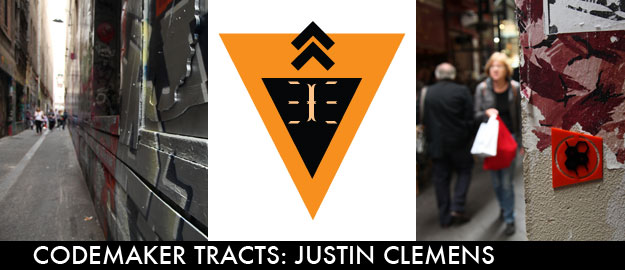Justin Clemens ::: University of Melbourne
The human species only became real — realized itself — when it became the most unreal of all animals. In the beginning was the virtual. This happened when the species contracted language, contracted it like a disease (as William Burroughs might say), or contracted it in a technically-binding way (as Thomas Hobbes might say). Language cuts the animal body from its immediate environment; language was the first and most determining of all virtual technologies. As soon as you start to speak, you can’t help but say things that aren’t. Words integrally transform the world, your body, your relationships to others. Things are damaged, destroyed, transformed in and by words. Words are world-destroying — which is why they are also world-creating. They tear possibility from what exists, and enable new sorts of impossible things to be envisaged, new sorts of tools to be invented, new sorts of dwellings to be constructed. Humans live in words much more than in places or, rather, every place is already a word-place too. This is the reason no-one will ever find any remains of the so-called ‘Missing Link’: the Missing Link was already a virtual ape, not an actual one. Today, when ‘technology has become nature for postmodern humanity,’ as the French philosopher J.-F. Lyotard said, we can’t miss our own virtuality any more. We can’t pretend we’re natural. We are all virtual apes, in all senses of this phrase. We virtually ape each other’s apings. And where do virtual apes live, but in virtual cities? For the first time in the history of the species, more humans live in cities than in the country. These cities, moreover, are not the cities of antiquity, nor even the cities of modernity. They are, rather, megacities, vast conurbations that, in their constant redevelopment and unprecedented growth, exacerbate both technological innovation and economic inequity. This fact has extraordinary implications. More virtual apes live more tightly packed in greater numbers than ever before. Technology is more determining for these cities than ever before. Virtual apes carry laptops and mobiles, are connected to each other, invisibly but inexorably. Our new virtual cities are wirelessly wired. Nothing that we see or do or think within these megapolises has not been patently mediated by such technologies — technologies that link the entire globe in real time, and link the internal redevelopment of place to events from everywhere else, in direct yet unpredictably complex ways. These megacities are also literally toxic dumps and energy sinks, breeders of metastatic disorders, irremediably polluted and irrevocably disorderly. The virtual ape has never, paradoxically, been more actualised, more materially available to itself as interacting bundles of technologically-enhanced cell-networks. At such a moment, a new gulf between virtuality and materiality yawns. What’s left to do in such circumstances, but to play games? Sure, all the old games still subsist in such cities: money, power, sex, reputation. They’ll never die as long as virtual apes are virtual apes. But the virtual apes can now play new games, never before possible, enabled by their virtual megacities. The entire space of the city can itself become the realm for pervasive play, which redisposes real bodies and places — in all their managed and unmanageable functionality — as elements for imperceptible, playful, social interactions. Not that you physically vanish in playing these games; on the contrary, you’re just as there as you ever were. But it is impossible to know what the movements of real persons in these real spaces mean from the outside, as their motivations and meanings have become entirely virtual. The man in the cheapish suit could be the arbiter of a deep game that implicates thousands of others; the fat woman with the bad pimples could be a double-agent for a cabal of designers. Function is suspended, or diversified, or repurposed for the point of the game. Virtual apes disappear into the abstract realm of pure play, into sets of dissimulating acts, forming transient and invisible social gangs in the megacity, making new connections and disconnections in the symbolic fabric of lives.
